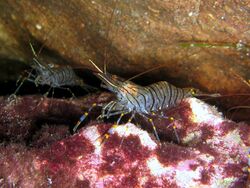Biology:Palaemon serratus
| Palaemon serratus | |
|---|---|

| |
| Scientific classification | |
| Kingdom: | |
| Phylum: | |
| Subphylum: | |
| Class: | |
| Order: | |
| Infraorder: | |
| Family: | |
| Genus: | |
| Species: | P. serratus
|
| Binomial name | |
| Palaemon serratus (Pennant, 1777) [1]
| |
| Synonyms [2][3] | |
| |
Palaemon serratus, also called the common prawn, is a species of shrimp found in the Atlantic Ocean from Denmark to Mauritania, and in the Mediterranean Sea and Black Sea.[4]
Ecology
Individuals live for 3–5 years[5] in groups in rocky crevices at depths of up to 40 metres (130 ft).[6] Females grow faster than males, and the population is highly seasonal, with a pronounced peak in the autumn.[7] They are preyed upon by a variety of fish, including species of Mullidae, Moronidae, Sparidae and Batrachoididae.[8]
Description
P. serratus may be distinguished from other species of shrimp by the rostrum, which curves upwards, is bifurcated at the tip and has 6–7 along its upper edge, and 4–5 teeth on the lower edge.[4] Other species may have a slightly curved rostrum, but then the teeth on its dorsal surface continue into the distal third, which is untoothed in P. serratus.[9] P. serratus is pinkish brown, with reddish patterns, and is typically 100 millimetres (3.9 in) long, making it the largest of the native shrimp and prawns around the British Isles.[10]
P. serratus is one of the few invertebrates to have its hearing studied in detail; it is sensitive to frequencies between 100 Hz and 3 kHz, with an acuity similar to that of generalist fish.[11] While the hearing range of a P. serratus individual changes as it grows, all are capable of hearing tones at 500 Hz.[12]
Fisheries
A small commercial fishery exists for P. serratus on the west coast of Great Britain,[5] chiefly in West Wales (Cemaes Head to the Llŷn Peninsula),[13] but extending increasingly far north to include parts of Scotland.[14] In Ireland, fishing for P. serratus began at Baltimore, County Cork in the 1970s and subsequently expanded. A peak landing of 548 t was recorded in 1999, and four counties account for over 90% of the catch — Galway, Kerry, Cork and Waterford.[15] There is now concern that the current levels of exploitation may represent overfishing, and measures are being considered to limit the catch, such as a minimum landing size.[13]
References
- ↑ "Palaemon serratus". Integrated Taxonomic Information System. https://www.itis.gov/servlet/SingleRpt/SingleRpt?search_topic=TSN&search_value=96451.
- ↑ "Palaemon serratus (Pennant, 1777)". 2008 Annual Checklist. Catalogue of Life. http://www.catalogueoflife.org/show_species_details.php?record_id=3805394.
- ↑ "Palaemon serratus". Aquaculture Compendium. CAB International. 2006. http://www.cabicompendium.org/NamesLists/AC/Full/PALAEN.htm.
- ↑ 4.0 4.1 "Common prawn (Palaemon serratus)". ARKive. http://www.arkive.org/common-prawn/palaemon-serratus/info.html.
- ↑ 5.0 5.1 Torry Research Station. "Handling and processing shrimp". Torry Advisory Notes — No. 54. Food and Agriculture Organization. http://www.fao.org/wairdocs/tan/x5931e/x5931e01.htm.
- ↑ "Marine Irish Digital Atlas". University College Cork. http://mida.ucc.ie/pages/atlas/atlas.php?theme=Fisheries/Aquaculture.
- ↑ Guillermo Guerao; Carlos Ribera (2000). "Population characteristics of the prawn Palaemon serratus (Decapoda, Palaemonidae) in a shallow Mediterranean bay". Crustaceana 73 (4): 459–468. doi:10.1163/156854000504543.
- ↑ Rita Sá; Constança Bexigaa; Pedro Veigaa; Lina Vieiraa; Karim Erzini (2006). "Feeding ecology and trophic relationships of fish species in the lower Guadiana River Estuary and Castro Marim e Vila Real de Santo António salt marsh". Estuarine, Coastal and Shelf Science 70 (1–2): 19–26. doi:10.1016/j.ecss.2006.05.038. Bibcode: 2006ECSS...70...19S.
- ↑ Christopher W. Ashelby, Tim M. Worsfold & Charles H. J. M. Fransen (2004). "First records of the oriental prawn Palaemon macrodactylus (Decapoda: Caridea), an alien species in European waters, with a revised key to British Palaemonidae". Journal of the Marine Biological Association of the United Kingdom 84 (5): 1041–1050. doi:10.1017/S0025315404010392h. http://decapoda.nhm.org/pdfs/24611/24611.pdf.
- ↑ M. R. Reeve (1968). "The suitability of the English prawn Palaemon serratus (Pennant) for cultivation — a preliminary assessment". FAO Fisheries Report (Food and Agriculture Organization) R57 (3): 582 pp. http://www.fao.org/docrep/005/ac741t/AC741T34.htm.
- ↑ J. M. Lovella; M. M. Findlaya; R. M. Moateb; H. Y. Yan (2005). "The hearing abilities of the prawn Palaemon serratus". Comparative Biochemistry and Physiology A 140 (1): 89–100. doi:10.1016/j.cbpb.2004.11.003. PMID 15664317.
- ↑ J. M. Lovell; R. M. Moate; L. Christiansen; M. M. Findlay (2006). "The relationship between body size and evoked potentials from the statocysts of the prawn Palaemon serratus". Journal of Experimental Biology 209 (Pt 13): 2480–2485. doi:10.1242/jeb.02211. PMID 16788031.
- ↑ 13.0 13.1 Jeremy Percy (2006). "The Welsh coastal Palaemon prawn fisheries — a consideration of future possible actions". North Western & North Wales Sea Fisheries Committee. http://www.nwnwsfc.org/archive/scibye_mins/scibye20apr07/percy_prawn_paper.htm.
- ↑ "Palaemon serratus: sustainable development". Seafish. http://www.seafish.org/b2b/info.asp?p=109.
- ↑ Edward Fahy; Niamh Forrest; Ruth Mortimer; Jim Carroll (2006). "Indicators of performance in the fishery for shrimp Palaemon serratus (Pennant) in Irish Coastal Waters". Journal of Shellfish Research 25 (3): 1021–1026. doi:10.2983/0730-8000(2006)25[1021:IOPITF2.0.CO;2].
External links
- Photos of Palaemon serratus on Sealife Collection
Wikidata ☰ Q2103330 entry
ja:スジエビ

